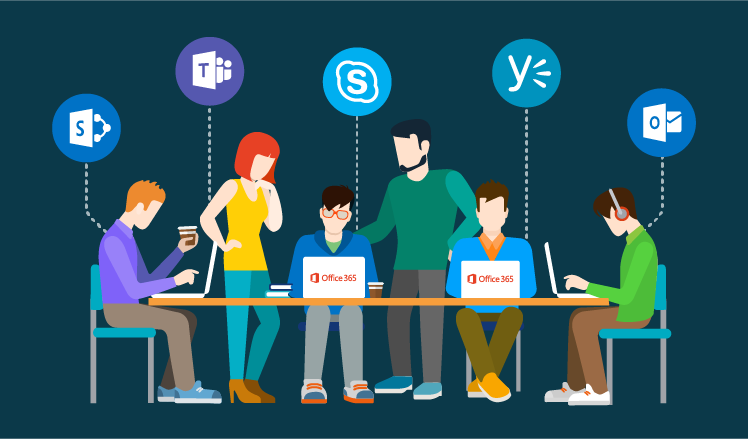
Blog / Software Musings – Part 2: Microsoft Introduce some NEW (Old) Tools to Enhance Collaboration
Last time, I introduced the topic of Line of Business (LoB) software as something that many organizations rely massively on. Most are heavily-customized applications that target a specific industry or user group, and they’re essential for keeping an organization running smoothly, as well as efficiently. Many have been operating for several years; sometimes decades, and they’ve been upgraded and enhanced several times to keep pace with Technology and user demands.
The message sent last time was that the feature set of the application is important; but so is the technical architecture and support. In fact, they may be MORE important than the components of the application. If it won’t run properly and securely on your network – or the Vendor doesn’t bolster it with user help and technical updates – it doesn’t really matter what characteristics it has.
Microsoft have jumped into the collaboration arena by introducing and including several tools in their Office 365 platform. Technically, Microsoft list these as “Services”; not Applications, because they need Cloud storage to operate. This might seem like a small point, but it is important. Even though it’s possible to have this hosted on the Microsoft servers in Canada, there may be some data you process that might not be appropriate for Office 365 in your line of work. Health data, employee data, and sensitive personal information about Clients or rate-payers come to mind.
The other Cloud-caveat that might come into play is the lack of stable and fast Internet access – especially in a larger office or when you’re manipulating/sharing large files. Performance might not be adequate, or worse – you might lose access to file or Team information. Finally, related to this, with your information in the Microsoft Cloud, you are effectively tied to them “forever and ever.” If you decide to move to a competing platform or stop paying your subscription, your collaboration information is going to disappear. It’s a SERVICE; not an application.
However, being forewarned, let’s examine some of the offerings – as they do have the potential to enhance your business operations:
– OneDrive: Is a Cloud Storage repository for files – think “My Documents” in the Cloud. It’s been around for years and allows you to store files both locally and in the Cloud. Files can be sync’d across multiple computers and devices; including Smartphones and Tablets. I personally use OneDrive for a variety of low-priority office and personal files. OneDrive does have some limited capability for sharing files across multiple users, but there is a better tool for this: SharePoint.
– SharePoint: SharePoint is another traditional Microsoft system that has been given new life under Office 365. This is like OneDrive, but much more powerful – think your “Network Drive” in the Cloud. SharePoint can also be accessed from multiple devices, including Tablets and Smartphones. SharePoint allows Office files (Word, PowerPoint, Excel, for example) to be dealt with collaboratively; in other words, multiple users can be working on the same file at the same time and all changes are preserved (with some limitations.) This dramatically reduces duplication and file-versioning problems that are very common in most offices. The storage capacity of SharePoint is massive. Beyond file sharing, SharePoint also possesses the ability to build office workflows – multi-step processes involving one or more team members. Workflows track and report on overall task processes and templates can be created for repeat tasks.
– Teams: Teams is a communications, collaboration and productivity tool for users. You can message team members or the whole team, attach documents, share videos, and do voice and video web conferences (it replaces Skype.) It can even replace your phone system by setting-up your traditional phone lines to give a dial-tone. You can create multiple office teams of users. Users can be members of multiple teams. Users can collaborate in Teams by using SharePoint files. Think of it as combining the best features of Text Messaging, Outlook Email, Skype, your Network Drive, and your phone into one Super-Service. There are traditional computer and Smartphone versions of Teams. With over 175 applications and integrations, Teams is certain to have something that enables employees to do more!
There’s a lot more to the new Office 365 to enhance your business operations – and we’ll spend more time in 2020 telling you about these new features. But let me leave you with two thoughts:
1. These powerful tools are generic, in that they are not customized to your type of operation, users, or current workflow. Thus, taking maximum advantage of the capabilities will require user-training, plus dedicated resources to implement, customize, maintain, and support your new Office 365 system. It’s not a trivial exercise.
2. Office 365 enhances your current LoB application; it does NOT replace it. However, many LoB vendors are augmenting their applications to integrate and extend the Office 365 Advanced Tools & Services.
Not all versions of Office 365 support all the new features. If you would like more information on Office 365 Applications & Services best suited for your operation, please contact me or your Account Manager for some stress-free Office 365.
Thanks!
Dave White
TRINUS
stress-free IT

















